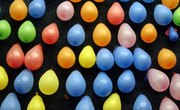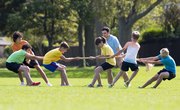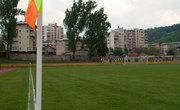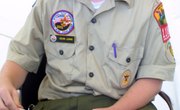Irish children's games include classic rhyming, chanting and clapping games, which are traditional throughout the United Kingdom. Some are contests of skill found in playrooms as well as pubs. Others are full-out bruising athletic competitions that hail back to the misty legends of magical warriors and fairy folk. Most share common elements with similar games played by kids in other cultures, and many are as popular with adults as they are with children.
Indoor Party Games
One game that makes use of the whole room is called "Corners" and is similar to musical chairs in that it requires participants to change places. Corners can be played by very young children and by five players at a time. One child stands in the middle, and the rest take the corners, which may be marked with a chalk "X," a paper plate or just a party-room corner under a balloon. The center player calls, "Change corners!" and everyone scrambles to claim a new corner, including the center child. The player left without a corner is out (loses) and must then take over the center. Prizes go to all four "winners" with consolation prizes to those who failed to grab a corner.
Tossing at Targets
For younger children, tossing games are simple variations of classic games that build skills. Older children use more sophisticated game equipment to refine their hand-eye coordination, and they play the same versions of traditional games as adults. Rings is a pub game, an Irish variation of Skittles (a game similar to bowling), playable anywhere but usually indoors. A wallboard with numbered hooks is securely mounted, and children stand behind a line and toss rubber rings at the hooks, trying to score by snagging rings on the hooks. Quoits, for children, has a cross-piece base with four corner posts and a center post. Each post is worth a different number of points. Kids toss stiff rope rings at the posts to score points each time a ring lands over a post.
Chase-and-Catch Games
Numerous Irish versions of chase-and-catch games are played during recess or after school. In Irish Bulldogs, children group behind one line some distance from an opposite line, while the "it" person stands in the middle and calls a name. That child must run to the opposite line without being tagged. Once someone is tagged, they join the center player, and both call "Irish Bulldogs!" Everyone runs to the opposite line, and those tagged remain in the center as the sequence is repeated until only one winner is left. Another example of such a game is Rats and Rabbits. Two teams line up across from two finish lines. One team assumes the role of rats while the other takes rabbits. Game play begins when a caller shouts either "Rats!" or "Rabbits!" If the caller shouts "Rats," then all the players on the rats' team must chase the players on the other team as the rabbits run and try to make it across to their finish line without being caught. If the caller shouts "Rabbits," then the same thing happens in reverse. The team with all players tagged first loses.
The History of Hurling
Hurling, an ancient ball-and-stick sport played on a grass pitch, boasts such illustrious players as the legendary mythical hero Cuchulainn. The game was such a source of national pride that the English once banned it, and it declined in popularity until the 19th-century Gaelic Athletic Association made it Ireland's national pastime. Hurling consists of two teams using wood sticks called "hurls" to move a sliotar -- a baseball-sized hard ball -- down a grass field to a goal post. The game is very physical, so children wear helmets and padding as they rush to the ball, shoulder each other out of the way, slap and grab at the ball mid-air and attack it with their sticks. The ball can be carried or whacked at with the wide, flat end of the hurl; the sport is a bruising one, but it is still taught in schools and played in amateur leagues.
Related Articles
References
Writer Bio
Benna Crawford has been a journalist and New York-based writer since 1997. Her work has appeared in USA Today, the San Francisco Chronicle, The New York Times, and in professional journals and trade publications. Crawford has a degree in theater, is a certified Prana Yoga instructor, and writes about fitness, performing and decorative arts, culture, sports, business and education .











